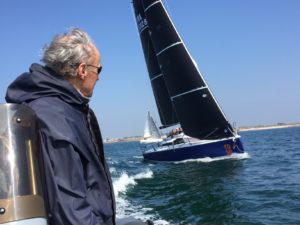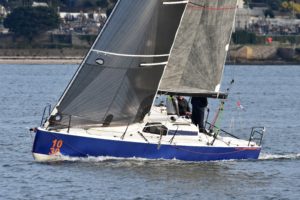JPK 1030
IRC Racing
How, under the IRC rules, can we further improve the performance of our Racing range without the performance-rating compromise becoming less favourable?
The only possibility for Jacques Valer, our designer, is to accept a loss of versatility on the full crew and three-mark-course in order to improve the performance in solo and double-handed sailing, with an adjustment of priorities. An early planing, great power when reaching and more generally a real ease in all points of sail: this is the formula of the JPK 1030.
Lighter, narrower on deck, more tension in the keel line, more volume in the forward sections than its predecessor, designed to run heeled with a reasonable wetted surface and not requiring too much surface area in the sails ... the concept is ambitious, but it's what's needed to perform in all race formats!
The genius of Jacques Valer and the many months spent on the design of this very elaborate hull should enable us to extend our line of champions.
Naval architect J. Valer
-
LOA 10,34 m
-
LWL 9,06 m
-
BOA 3,24 m
-
Displacement 3,7 t
-
Volvo engine 20 cv
-
Keel 1,5 t
-
Draft 1,98 m
-
Main 35 m²
-
Genoa 26 m²
-
Asy spinnaker 105 m²
-
Symetric spinnaker 95 m²
After four solo and double-handed Transquadras and many miles sailed offshore, the JPK 1030 is really the perfect boat I had in mind to perform and have fun. It's a real " scooter " that allows you to push hard on the boat in complete safety for a maximum of pleasure.
Jean-Pierre Kelbert
How did the 1030 come to be?
by JP Kelbert
The hull of the JPK 1030 was born on the return from the 2018 Transquadra, after my second place on the JPK 1080 against the Beepox 990 skippered by Alex Ozon.
On the one hand, a boat of 10 meters by 3 wide and 2.5 t of displacement, on the other hand a boat of 10.80 meters by 3.50 wide for 4.8t.
As 90% of the Transquadra is sailed downwind, a good VMG boat is of course ideal for winning. From this point of view, the Beepox was the perfect boat to plan early and to keep high averages above 18-20 knots, which was the case on the first and second leg of this edition. Obviously, this very typical boat is not very efficient upwind (especially in breeze) and cruelly lacks power on certain courses.
From this observation, I asked Jacques Valer to design a boat capable of planing a bit earlier than a JPK 1010 (4 times winner of the Transquadra) or a JPK 1080, but also of gaining power on the reaching, while remaining efficient upwind.
Here again, Jacques' work was not easy; several versions were made, including a very "scow" version, which was judged too typical. The rating increases very quickly when the boat is lightened or powered, so there is very little margin for manoeuvre in order to maintain versatility and save the rating in most conditions... especially when faced with boats such as the JPK 1010, which is ultra-versatile and has an interesting age allegiance!
The JPK 1030 is therefore relatively narrow, with very full forward sections and a smaller hull cavity for a more tensioned hull slope. When heeling, the hull is also well tensioned to favour heeled boat planning.
The 300 litre ballast tanks compensate for the rather light straight keel. They are useful starting from 10/12 knots of wind upwind, but also when reaching in a breeze.
On the water, the boat is exactly where we expected it to be, super efficient on the reach, planing, but also very efficient upwind from 10 knots of wind, when below this threshold you have to accept to increase the rating by an extra surface in light airs.
The results over two seasons speak for themselves and there is still plenty of room for improvement, particularly in terms of sail configuration and design.
Made of Airex / glass / vynilester sandwich, the deck, hull and all accommodation structures are made under vacuum by infusion.
The draping plan and the choice of the different layers of fabric make it possible to optimise the weight, with substantial reinforcements in the areas subject to stress and very light structures at the top of the shell and on the deck.
The IRC favors a type of keel known as "flat", without a bulb. The centre of gravity (CG) of this type of keel is therefore higher and requires more powerful hull sections.
The large surface area of the center of efforts allows the profiles to engage very quickly, even at low speeds.
Our keel is a cast iron-lead combination with a sophisticated construction made by the Lemer foundry. The inner insert and the GS cast iron flange provide a lot of rigidity to the assembly and allow to keep a thin profile until the base of the hull.
The insert is then placed in an outer profile mould at the foundry for the casting of the lead.
On each boat, the sole is laser aligned with a moulding in the bottom of the hull before being fixed.
The keel profiles are jigged and the epoxy coatings are "shimmed" before painting.
In the event of a heel strike, the long, recessed sole distributes the load over all the struts and the lead absorbs the energy of the impact.
Despite the racing-oriented programme, the interior of the JPK 1030 is bright, warm and well finished: fully compatible with a cruising programme!
The boat can be equipped with an oven, heater, pressurised hot water unit, indirect LED lighting and dimmers integrated into the counter mould.
For racing, the double watch seat and the rear seats are preferable, and an optional ball pouffe for interior and exterior comfort is available.
The boat's single and double-handed programme requires perfect dimensioning and positioning of the deckware.
Harken has been our supplier for 20 years and supports us in the preparation of bills of material.
The cockpit's ergonomics are the result of extensive work on a full-scale model during the construction of the deck mannequin. Ideal steering position to hold on to for a long time, natural manoeuvring position... comfort is a key factor in performance.
Our lastest news about the JPK 1030

JPK 1030 – LEEUWIN – 2021
A Vendre – JPK 1030 – Leeuwin – 2021 Visible à St Malo. 5e de la dernière cap Martinique10e Cowes Dinard 22 et 12e Cowes

JPK 1030 – Vaïana – 2021 – LOCATION
A louer – JPK 1030 – VAïana – 2021 Jusqu’à l’arrivée de la Cap Martinique 2026. Palmarès. Etat neuf, Très bien équipé, entretien constant et

JPK 1030 – MOMO – 2019
A Vendre – JPK10.30 – Momo – 2019 ex: Telemaque III C’est un vainqueur de course avec des spécifications très élevées. Système de ballasts démonté











